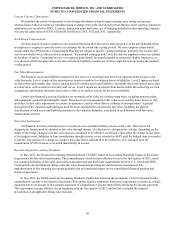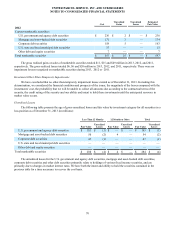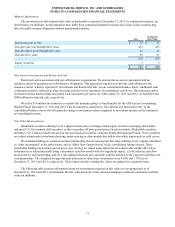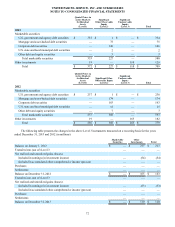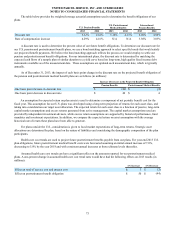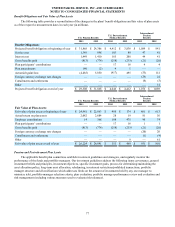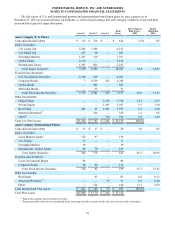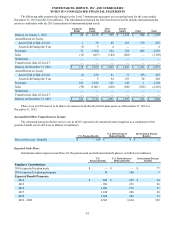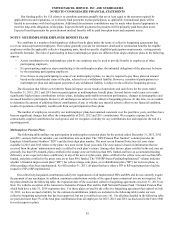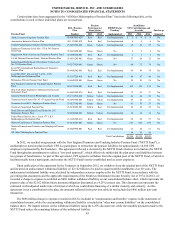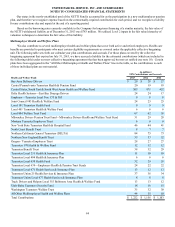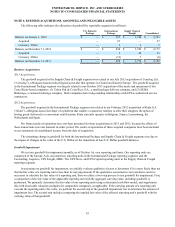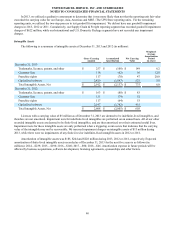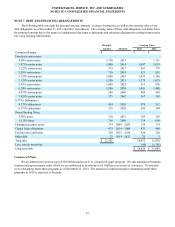UPS 2013 Annual Report Download - page 90
Download and view the complete annual report
Please find page 90 of the 2013 UPS annual report below. You can navigate through the pages in the report by either clicking on the pages listed below, or by using the keyword search tool below to find specific information within the annual report.
UNITED PARCEL SERVICE, INC. AND SUBSIDIARIES
NOTES TO CONSOLIDATED FINANCIAL STATEMENTS
78
Our investment strategy with respect to pension assets is to invest the assets in accordance with applicable laws and
regulations. The long-term primary objectives for our pension assets are to: (1) provide for a reasonable amount of long-term
growth of capital, with prudent exposure to risk; and protect the assets from erosion of purchasing power; (2) provide
investment results that meet or exceed the plans’ expected long-term rate of return; and (3) match the duration of the liabilities
and assets of the plans to reduce the potential risk of large employer contributions being necessary in the future. The plans
strive to meet these objectives by employing portfolio managers to actively manage assets within the guidelines and strategies
set forth by the benefit plan committees. These managers are evaluated by comparing their performance to applicable
benchmarks.
Fair Value Measurements
Pension assets utilizing Level 1 inputs include fair values of equity investments, corporate debt instruments, and U.S.
government securities that were determined by closing prices for those securities traded on national stock exchanges, while
securities traded in the over-the-counter market and listed securities for which no sale was reported on the valuation date are
valued at the mean between the last reported bid and asked prices.
Level 2 assets include certain bonds that are valued based on yields currently available on comparable securities of other
issues with similar credit ratings, mortgage-backed securities that are valued based on cash flow and yield models using
acceptable modeling and pricing conventions, and certain investments that are pooled with other investments held by the trustee
in a commingled employee benefit trust fund. The investments in the commingled funds are valued by taking the percentage
owned by the respective plan in the underlying net asset value of the trust fund, which was determined in accordance with the
paragraph above.
Certain investments’ estimated fair value is based on unobservable inputs that are not corroborated by observable market
data and are thus classified as Level 3. These investments include commingled funds comprised of corporate and government
bonds, hedge funds, real estate investments and private equity funds. The fair values may, due to the inherent uncertainty of
valuation for those alternative investments, differ significantly from the values that would have been used had a ready market
for the alternative investments existed, and the differences could be material. These investments are described further below:
• Commingled Stock Funds: We maintain plan assets invested in commingled stock funds, which hold U.S. and
international public market securities. These commingled funds are valued using net asset values, adjusted, as
appropriate, for investment fund specific inputs determined to be significant to the valuation. Our plans maintain the
right to liquidate positions in these commingled stock funds at any time, subject only to a brief notification period. No
unfunded commitments existed with respect to these commingled stock funds at December 31, 2013.
• Hedge Funds: We maintain plan assets invested in hedge funds that pursue multiple strategies to diversify risk and
reduce volatility. Investments in hedge funds are valued using reported net asset values as of December 31. These
assets are primarily invested in a portfolio of diversified, direct investments and funds of hedge funds. Most of these
funds allow redemptions either quarterly or semi-annually after a two to three month notice period, while other funds
allow for redemption after only a brief notification period with no restriction on redemption frequency. No unfunded
commitments existed with respect to these hedge funds as of December 31, 2013.
• Real Estate and Private Equity Funds: We maintain plan assets invested in limited partnership interests in various
private equity and real estate funds. These private equity and real estate investment funds are valued using fair values
per the most recent partnership audited financial reports, adjusted as appropriate for any lag between the date of the
financial reports and December 31. The real estate investments consist of U.S. and non-U.S. real estate investments
and are broadly diversified. Limited provision exists for the redemption of these interests by the general partners that
invest in these funds until the end of the term of the partnerships, typically ranging between 12 and 18 years from the
date of inception. An active secondary market exists for similar partnership interests, although no particular value
(discount or premium) can be guaranteed. At December 31, 2013, unfunded commitments to such limited partnerships
totaling approximately $858 million are expected to be contributed over the remaining investment period, typically
ranging between three and six years.


